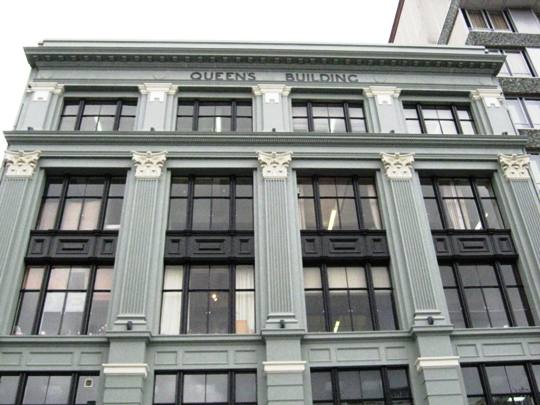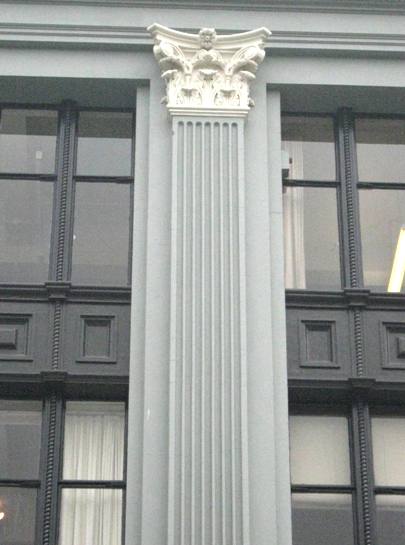Situated on Princes Street, the Queen’s Building was designed by Salmond and Vanes and built by Lawrence and Sons in 1926 for Charles Speight. The Queen’s Building with its classical elements, makes an important contribution to the streetscape of central Dunedin’s main street Princes Street. Both iwi history and archaeological evidence show Māori occupation in the Ōtākou / Otago region since the 12th century. Today, Kāi Tahu mana whenua is recognised over a large part of Te Wai Pounamu. Kāti Māmoe and Waitaha shared occupation are always acknowledged. The hapū Kai Te Pahi, Kāti Moki, and Kāti Taoka still maintain their presence and responsibility as kaitiaki in this region. While there were no permanent settlements around Princes Street, the area near the Toitū Tauraka waka (List No. 9774) was known as Ōtepoti. Originally the land parcel was Section 3, Block XV, Town of Dunedin. In 1875 the section was occupied by J.W. Allen who owned a portrait gallery and premises, The Queen’s Theatre and a smaller shop and premises. The Queen’s Theatre was erected in 1872 by the Friendly Societies. The hall was regularly leased out for dancing and events. Significantly, the first performance of God Defend New Zealand written by poet Thomas Bracken was held here. From 1887 the theatre was the headquarters for the Salvation Army. In 1891 the land with the Queen’s Buildings was purchased by Sir Francis and James Smith who then leased the building to Lorie and Co who remodelled the building as an auction house. In 1926 Charles Speight became owner of the property and began construction of the Queen’s Building. Speight was born in Dunedin in 1865 the son of James who established the Speights brewery in 1876. Charles was involved in the business and eventually became managing director. He held directorships in other companies. He died in February 1928 before the completion of the Queen’s Building. The original building had four stories indicating the top storey, with the name ‘Queen’s Building’, which was added later. Salmond and Vanes were the architects with Lawrence and Sons the builders. The plans show the building provided three shops on the ground floor and offices on the first, second and third floors. ‘The expansive front has been finished with coloured cement and a special stone finished, cream-toned in texture. The architectural design is attractively classical, presenting a facade that is boldly proportioned with heavy projections and enriched cornices. Fluted Corinthian pilasters, rising from the second floor to the top of the floor make an effective design, and the general aspect of massiveness and solidity is relieved by the large windows on each floor, set in bronze finished -steel frames and sashes…Opening from the street is a 10 foot entrance, which leads to the fama-finished staircase, the lift and the Vedic tea rooms. This, with the three shop fronts, occupies the whole of the street frontage. The building is a steel-framed structure throughout, with concrete floors, ceilings, and walls, the only woodwork being doors and skirting and the jarrah flooring that covers the concrete floors.’ Behind the Queen’s Building proper and linked to it is a smaller building which was reconstructed beside the original Queen’s Theatre. Located at the rear of the new five-storey building, and accessed down a wide passage from Princes Street, was Vedic’s Café with their spacious rooms connected to the latter by a large lounge lit from above by an elaborate leadlight dome. The café operated for many years and was used as a venue for wedding dances and twenty-first birthdays from 1920-1961. The Vedic was converted in 1961 into rooms for the TAB and later the Mid City Tavern in 1988. It is unclear whether the smaller building, which housed the Vedic was constructed when the Queen’s’ Building proper was built or whether it was earlier. It is possible the Queen’s building incorporates part of the original Queen’s Theatre. The Queen’s Building also housed many tenants – some for many years - including: Vedic Café, University Club, Parisian Mantle Company, Pattison-Ede furriers, Lambert’s Tailor, Red Cross, Plunket (from 1933), Tyrrell and Turpin Accountants, Black and White Milk Bar (Pagoni’s), Kemra Milk Bar, National Party, Auckland Building Society, Suit Surgeons, Shooters Bar 1998 - 2004, Heritage New Zealand Pouhere Taonga, and Black Dog Café from 2004 to the present day.



Location
List Entry Information
Overview
Detailed List Entry
Status
Listed
List Entry Status
Historic Place Category 2
Access
Private/No Public Access
List Number
2205
Date Entered
7th July 1982
Date of Effect
7th July 1982
City/District Council
Dunedin City
Region
Otago Region
Extent of List Entry
Extent includes the land described as DP 3626 (RT 41762), Otago Land District and the building known as Queen’s Building thereon.
Legal description
DP 3626 (RT 41762), Otago Land District
Stay up to date with Heritage this month
